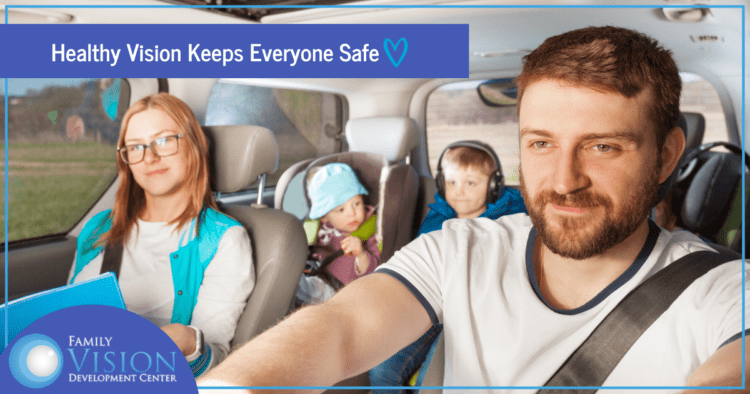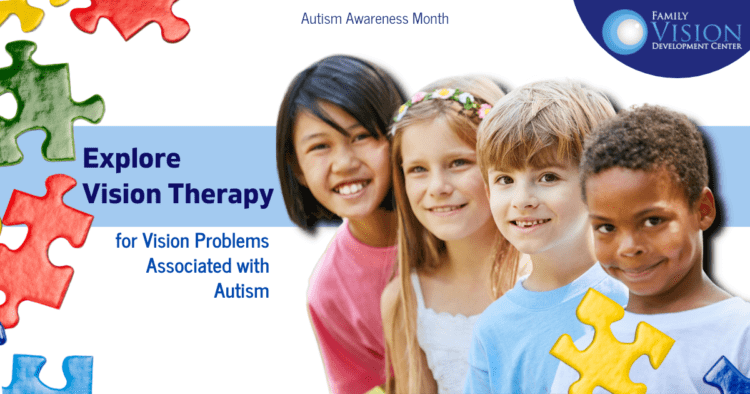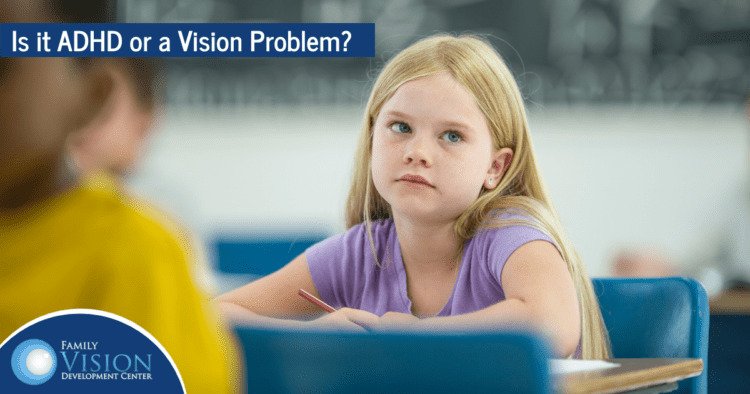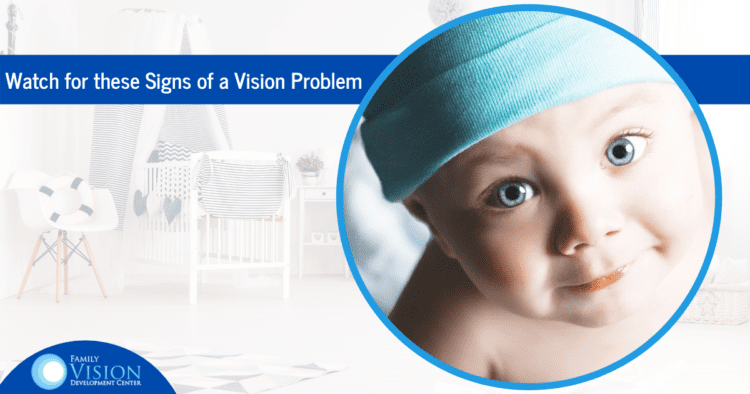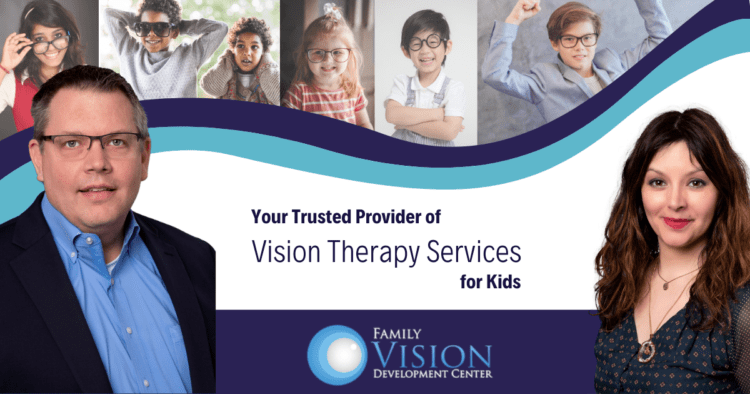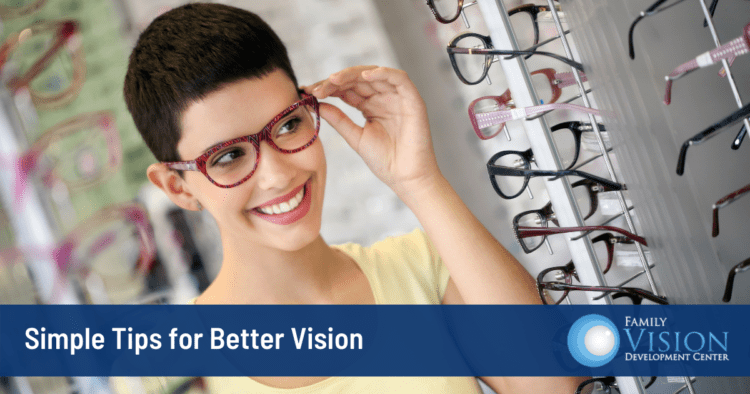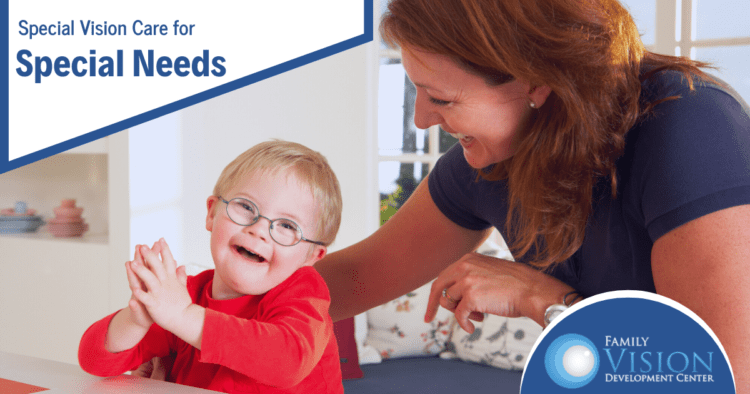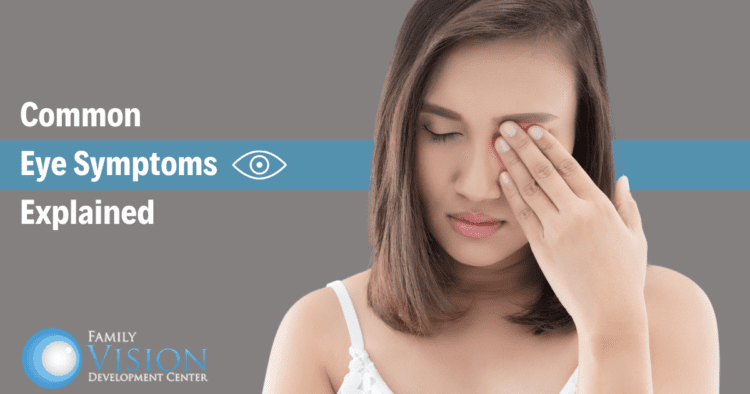Learning to safely drive a car includes passing a driving exam, understanding the functions and safety features of your car and of course, a lot of practice. But what they might not stress in driving school is the important role that healthy vision plays in road safety. So along with regular maintenance on your vehicle, make sure you place the same importance on maintaining your vision to ensure a safer driving experience.
Age can make a difference
Of course it is important to take care of your vision at every age. But when it comes to driving, there are certain age groups that may encounter more difficulty if their vision is compromised. For example, young people with new driver’s licenses, as well as older drivers, may experience problems with focus and attention while driving, along with slower reaction times when on the road. These additional risk factors make maintaining good vision even more important for staying safe while driving.
Vision disorders can make driving difficult
There are a number of ways that a vision disorder can create an unsafe situation for a driver. Inside the car, it can greatly impact a driver’s ability to read essential information on the vehicle’s dashboard or navigation system. Additionally, out on the road it can prohibit them from safely seeing and reacting to road hazards, warning signs, other vehicles or pedestrians, as well as completing basic maneuvers such as merging, parking or backing up. Some common vision conditions that can affect safe driving include:
- Macular degeneration
- Glaucoma
- Retinal disease
- Cataracts
- Strabismus
- Amblyopia
- Nearsightedness
- Farsightedness
- Vascular disease
- Retinal detachment
- Diabetic retinopathy
- Dry eye
If a driver suffers from any of these vision disorders, it can cause them to experience symptoms like poor depth perception, increased glare, a limited field of vision or slower response times – all of which can create potential danger while driving.
Regular eye exams are essential
Once you start driving it is imperative to take care of your vision, for your own safety as well as that of your passengers. One of the most important ways to do that is to get regular eye exams. At Family Vision Development Center, our comprehensive vision exams allow us to gather important health information to determine your likelihood of developing certain vision disorders. Additionally, regular monitoring allows us to detect any changes in vision early on and quickly provide corrective treatment.
We are committed to providing our patients with exceptional care and helping to ensure they remain safe out on the roads. Along with professional vision exams, we can hep you select the right pair of eyeglasses or contact lenses to best suit your driving habits and lifestyle. And we even have a great selection of high-quality protective sunglasses from designer brands like Maui Jim and Nike. Contact our Aurora office at 630-862-2020 to learn more or to schedule your appointment.
Additional information can be referenced here
Children with autism are faced with many challenges every day, including possible issues surrounding communication and social skills, increased sensitivity, sleep problems, and speech and language difficulties. Additionally, kids with Autism Spectrum Disorder (ASD) can experience problems with their visual system, and are often more likely to have vision issues than children without ASD. It is a good idea for parents of kids with autism to explore the possibility of certain vision conditions, as well as understand what treatment options are available.
Types of Vision Issues and Behaviors Common in Kids with Autism
Many traits and behaviors that are commonly experienced by children with ASD are similar to symptoms of certain vision conditions. Oftentimes it is difficult to know if the symptoms are due to ASD alone, if it is an actual vision problem, or even a combination of both. One or more of the following conditions or behaviors can be attributed to both autism and vision issues:
- Lack of eye contact
- Staring at light or spinning objects
- Eye movement disorders
- Crossed eyes
- Difficulty following an object with their eyes
- Amblyopia/lazy eye
- Light sensitivity
- Rolling eyes
- Looking at objects from the sides of their eyes
A functional vision evaluation is important to help determine a child’s visual ability in aspects such as eye teaming and tracking, eye movements, visual processing, visual-spatial judgment and peripheral vision.
Vision Therapy Programs can be Very Effective
Vision therapy is like a kind of physical therapy for the visual system, including the eyes and brain, and can be an extremely effective form of treatment for kids with ASD. Through the use of specialized eye exercises and visual activities that are customized to target the specific needs of each individual child, a vision therapy program can help to restore visual abilities such as focusing, tracking objects, sustaining attention to visual information and coordinating visual stimuli with movements. For a child with autism, regaining ability in these areas can help them to interact more fully with their environment and improve their overall quality of life.
We Can Help Diagnose and Treat Vision Conditions Associated with Autism
The caring, professional team at Family Vision Development Center is experienced in working with kids with ASD and is a trusted provider of comprehensive eye care services for our most vulnerable patients. Starting with a comprehensive vision exam and functional vision evaluation, we can properly diagnose any vision issues that may be associated with a child’s autism. Furthermore, our doctors have specialized training in the most up-to-date vision therapy techniques so we can provide the most advanced treatment options. Contact our Aurora office at 630-862-2020 to learn more or to schedule your appointment.
Additional information can be referenced here
If your child has been diagnosed with ADHD, you may want to have their vision checked before committing to medication alone to improve their symptoms. In fact, children are frequently misdiagnosed by their doctor, simply because the symptoms of ADHD are so similar to those of some vison disorders. Parents should do their research and make sure they have all the facts and necessary testing completed before deciding on the appropriate treatment for their child.
Why Vision Problems get Misdiagnosed as ADHD
ADHD is a relatively common disorder for kids to suffer from, so when a child presents with the typical symptoms, their doctor may be quick to diagnose it as the cause. However, a number of vision disorders have many of the same symptoms as ADHD. This can result in a child being prescribed medication as a cure, when what they really need is vision correction. If a child has any of the following symptoms, it could be due to ADHD or a vision problem (or both), which is why a correct diagnosis can be tricky:
- Struggles to pay attention or concentrate in class
- Difficulty with reading or writing
- Tests poorly, even when they know the material
- Makes careless mistakes
- Starts assignments but has trouble completing them
- Poor performance in sports
- Has trouble organizing tasks
Due to the similarities in symptoms, if your child is suspected of having ADHD, it is wise to also get them tested for a vision disorder.
Vision Disorders That Can Mimic ADHD Symptoms
When a child has problems with their functional vision, certain visual skills become lacking, which results in symptoms like those of ADHD.
Functional vision is how your complete visual system, including your eyes, brain and the visual pathways between them, work together to make sense of the world around you, and help you understand and interact with your surroundings. It allows you to see objects with depth and dimension (like a ball, for example), and understand how to interact with it (catch it).
Problems with functional vision means the eyes and brain do not work together properly and can result in difficulty with focusing, depth perception, tracking skills, reading comprehension, hand-eye coordination and more. The symptoms of these vision issues, such as loss of concentration, not paying attention in class, rushing through work with careless mistakes, poor sports performance, etc., are often confused with those of ADHD. Therefore, getting your child evaluated for functional vision disorders can help you determine the best course of treatment.
Vision Therapy as Treatment
Vision therapy can be a very effective form of treatment for functional vision disorders. However, it can also be the right choice as an additional form of treatment for kids who have ADHD, as many of these children also have vision issues that require treatment.
Vision therapy is like physical therapy for the visual system. Through a series of therapeutic eye exercises and activities, a vision therapy program can retrain the eyes and brain to function together properly and restore proper visual skills. Our specially-trained vision therapy providers tailor our programs to each individual, based on the visual issues that have been diagnosed. The 30-40 minute sessions take place right in our office, with some at-home practice often recommended. Vision therapy is remarkably successful in treating functional vision problems and can often even eliminate the need for ADHD medications and the side effects that go with it.
Contact our office at 630-862-2020 to learn more about the similarities between ADHD and vision disorders, and to have the proper testing completed, so you can be confident in your treatment decisions.
Additional information can be referenced here and here
As a parent, protecting your child is one of your most important jobs. From using seatbelts in the car to teaching them about stranger danger, your child’s safety and security is always at the top of your mind. Parents may not think of their child’s vision as something that needs protecting, but healthy vision is something they need to succeed throughout their entire life! Follow these helpful tips to provide the best possible chance of a lifetime of healthy vision for your child.
During pregnancy
Your child’s vision begins developing in the womb, so you can give them an advantage starting during your pregnancy:
- Eat yellow, orange and red fruits and vegetable which are high in beta carotene, which converts into vitamin A and can help in the healthy development of your baby’s eyes
- Increase your lutein and zeaxanthin levels, which are important for your baby’s developing retina and brain, by eating green, leafy vegetables, corn or brightly colored fruits and vegetables
- Don’t smoke, as smoking during pregnancy has been associated with an increase in vision problems in children later on
At home
One of the best places to really make a difference in your child’s vision is at home! Starting from a young age, and continuing as they grow, try the following strategies:
- Provide visually-stimulating toys and mobiles for your baby to help encourage visual development
- Encourage puzzles, building blocks, arts and crafts as they get older to help develop hand-eye coordination skills
- Make sure sharp objects and dangerous chemicals are out of reach
- Feed them a healthy, well-rounded diet that includes plenty of fruits, vegetables, lean meat, poultry and fish which provide important vitamins and minerals that promote overall eye health
- Make sure they wear sunglasses with 100% UV protection whenever they are outside, to protect their eyes from harmful UV rays that can damage their eyes and increase the risk of cataracts or macular degeneration later on
In school
You can’t always be with your child, but you can encourage healthy practices for protecting their vision while they are away. When they are in school:
- Have them use a blue light filter on digital devices they use in the classroom or for remote learning
- Remind your child to try to look away from their screen every 20 minutes if possible, to avoid eye strain and give their eyes a needed break
- Always make sure they wear protective eyewear, such as goggles, eye guards or full face guards when participating in sports
For a lifetime of eye health
Protecting your child’s vision is not always based on one specific place. There are things you can do throughout their life to ensure they have the healthiest possible vision:
- Take them for regular eye exams starting at age 6 months, 3 years, before kindergarten and then yearly after age 5
- Take corrective action as soon as possible after receiving a diagnosis of any vision condition, including eye glasses or more advanced vision therapy treatments
- Encourage good hygiene habits, including proper hand washing and keeping their hands away from their eyes, to avoid eye infection or scratches.
- Pay attention to any warning signs of a problem with your child’s vision, including increased squinting, eye rubbing, light sensitivity, poor hand-eye coordination or eyes that turn in the wrong direction
At Family Vision Development Center, we are committed to providing the best possible eye care to your whole family, at all stages of your child’s development. Our comprehensive vision exams allow us to quickly detect any vision issues and develop the best treatment plan, such as glasses, contacts or an effective vision therapy program. Contact our Aurora office at 630-862-2020 to get more information or to schedule your appointment!
Cataracts are the result of the eye’s natural lens becoming cloudy. When cataracts are present, there are noticeable vision changes that come with it. For example, blurry vision is an extremely common result. Additionally, you may become extra sensitive to light, have trouble seeing at night or experience double vision. While these symptoms can make daily living more difficult, there are some ways to make functioning with cataracts easier.
Sunlight Protection
One of the best ways to slow the progression of cataracts is to make sure your eyes stay protected from the sunlight. Wearing the right sunglasses is essential, and can make a big difference for proper UV and glare protection. You might want to choose sunglasses with special tints or coatings, or anti-glare lenses. Additionally, you can also find select styles of eyeglasses that also provide anti-glare options. Our expert team can help you choose the perfect glasses to fit your lifestyle and needs.
Diet
There has been a lot of research that shows that nutrition can play a big role in slowing the progression of cataracts. The results of numerous studies have indicated that increasing your levels of antioxidant vitamins C and E, as well as the nutrients lutein and zeaxanthin, reduced the risk of both the development and progression of cataracts. Vitamin C can be found in many citrus fruits and green vegetables while foods such as nuts and seeds are a good source of vitamin E. To increase your lutein and zeaxanthin, eat more green leafy vegetables, squash, pumpkin or carrots.
Eye Exercises
Certain eye exercises can help to strengthen your eyes and ease eye strain. And while strengthening your eye muscles cannot actually cure cataracts, it can help to slow the progression. Try gently rolling your eyes in a clockwise circle a few times, then reverse to a counterclockwise motion. You can also try moving your eyes from side to side, or in the shape of a figure 8. Another exercise to try could be changing focus, by focusing on a finger held a few inches from your face, then shifting to an object farther away, then back again.
Lifestyle Changes
Making some changes to your daily activities can help make life easier when you have cataracts. For example, magnifying devices and reading lights can help ease eye strain for reading or other activities. Also, it is wise to limit nighttime driving, as cataracts can cause glare around headlight or streetlights, making it difficult to see.
Develop a Plan With Your Eye Doctor
One of the most important ways to manage your cataracts is to see your eye doctor regularly. The professional team at Family Vision Development Center is committed to helping our patients with cataracts live a full and rewarding life. During your comprehensive eye exams, we can closely follow the progression of your cataracts and detect any changes in vision as early as possible. Additionally, we can ensure that you have the most accurate and up-to-date prescription for your eyeglasses. During your visits, we will make sure you have a cataract treatment plan in place and will explain all of your options, including the possibility of surgery if your cataracts start to interfere too much with your quality of life.
Contact our Aurora office at 630-862-2020 to learn more or to schedule your appointment.
As a parent, one of the most important things in life is ensuring the happiness and well-being of your baby. You do your best to make sure they have everything they need, but it can be difficult at times to know if something is wrong, especially when it comes to a vision problem. Because they cannot speak, they can’t come right out and tell you that they are having trouble with their vision. But luckily there are some other ways to discover if there might be a problem with their eyesight.
Common Vision Problems in Infants
Before understanding the signs of a vision problem, it’s important to know some of the most common conditions that affect infants and children.
- Refractive errors – in which light does not focus correctly on the retina. This usually results in blurry vision, causing kids to have difficulty seeing things up close (farsightedness), far away (nearsightedness), or both (astigmatism).
- Lazy eye (Amblyopia) – a disorder that occurs when the eyes and brain do not work together properly, causing the brain to favor one eye. This can cause blurred vision, poor depth perception or one or both eyes to drift in and out.
- Strabismus – a condition in which the eyes are not lined up properly, leading them to point in different directions. This can cause a child to experience double vision, or seeing an object in two different places at the same time.
- Blocked tear duct – which occurs when the eye’s drainage system for tears is obstructed. Tears cannot flow properly, often leading to an irritated or infected eye.
There are, of course, many more conditions that can cause a vision problem in an infant. Disorders such as pediatric glaucoma or pediatric cataracts are more rare, but they can result in difficulty with vision and can even lead to vision loss. These issues and more can be discovered during your child’s eye exam.
Signs to Watch Out For
So the question is, how do you determine if your child is experiencing a vision problem if they can’t tell you? Apart from an eye exam, any of the following symptoms can indicate a possible reason to be concerned:
- Eyes that look like they are crossed or looking in different directions (after the first month or two)
- Unable to follow an object with both eyes
- Excessive watering
- Head tilting or turning to one side
- Extreme sensitivity to light (after the first month or two)
- Frequent crust in either eye
- Drooping eyelids
- Eyes look cloudy
- Eyes that flutter or move back and forth
- Frequent squinting
When to Visit the Eye Doctor
It is important to establish good habits right from the start for regular eye exams for your child. They are extremely valuable for maintaining your child’s healthy vision throughout their life. Of course, if you ever have any concerns at all about a vision problem, visit your eye doctor immediately. But as a rule, the recommended ages for eye exams for children are 6 months, 3 years old and before kindergarten. Following that, they should be performed yearly after age 5.
At Family Vision Development Center, we provide thorough, professional care to all members of the family in our friendly Aurora location. We specialize in vision therapy services for kids of all ages and are here to answer all of your questions regarding your child’s vision. Contact us at 630-862-2020 to learn more or to schedule an appointment.
Additional information can be referenced here
Most parents understand the importance of protecting their child’s vision. After all, success in school, in sports and in life in general are all tied to healthy vision. So when a parent notices that their child is experiencing issues with their vision, they want to know the best options available to treat the problem. Glasses or contacts are possible solutions for some disorders, but not all. Vision therapy is an extremely effective form of treatment for a wide range of vision conditions, and kids can truly benefit from the process. Here is some important information to get you started, so you can discover if vision therapy might be the right choice for your child.
What is Vision Therapy?
Vision therapy is a kind of physical therapy for the visual system, which includes the eyes and the brain. This therapy uses specialized eye exercises to help patients develop or recover normal visual skills. Completing this vision training can help kids (or adults) improve their vision so they are better able to perform daily tasks like reading, writing, driving, athletic participation and much more.
What is Involved in a Vision Therapy Program?
Creating a custom-tailored program for your child starts with a comprehensive vision exam. Once a vision disorder has been appropriately diagnosed, a vision therapy plan is developed to meet the specific needs of your child. A majority of the therapy is completed right in our office, with some at-home exercises designed to support our in-person sessions. Appointments are simple and comfortable for kids, usually lasting 30-45 minutes and involving short activities or games to complete the eye exercises.
What Disorders can Vision Therapy Help Treat?
We have seen remarkable success when using vision therapy as a treatment in the following situations:
- Binocular vision impairments – which occur when the eyes do not work together as a team. This can result in disorders such as amblyopia (lazy eye), strabismus (crossed eyes), esotropia (eye turns inward), exotropia (eye turns outward) or hyperphoria (eye turns upward)
- Focusing issues – keeping objects in focus when looking from one object to another
- Eye tracking issues – inability to smoothly follow an object from one place to another
- Visual processing problems – when the brain does not correctly interpret visual information
- Visual impairments sustained due to post-concussive vision syndrome or a traumatic brain injury
- Visual issues caused by certain genetic conditions present in some special needs individuals
- Computer vision syndrome – caused by excessive digital screen exposure
Vision Therapy is our Specialty
At Family Vision Development Center our specialty is providing custom, personalized vision therapy programs to meet the needs of our patients. Our highly-qualified doctors have completed advanced training so you can feel confident that your child is receiving the best possible care. Dr. Martin is an optometrist & vision rehabilitation specialist with special training in vision therapy and vision development, who is also pursuing a fellowship from the Neuro-Optometric Vision Rehabilitation Association. Dr. Santoyo-Johnson is also an optometrist and vision rehabilitation specialist, and is the only provider in the area who is a Board Certified Fellow in light therapy by the College of Syntonic Optometry.
We look forward to working with your family and providing the best treatment options for your child in order to restore their vision to the fullest extent possible. Contact our office at 630-862-2020 to learn more and to schedule your appointment.
Additional information can be referenced here
It’s that time again! The start of a new year means thinking about all the great ways you can improve your life, in order to be happier and healthier. Interestingly, you might find that some of the common goals such as eating better or quitting smoking can also help you achieve another important goal – improved vision! Here are a few easy ways you can work to protect your eyesight.
Diet Tips
Changes in diet are often at the top of new year’s resolutions lists. But besides the obvious health benefits of eating better, a better diet can also have lasting improvements to your vision. Making these easy changes to the food you eat can add important vision-friendly nutrients into your diet.
- Increase your omega-3 fatty acids with fish, nuts or seeds
- Get more vitamin C with citrus fruits and leafy green vegetables
- Eat foods rich in vitamin E like nuts and legumes, seeds, sweet potatoes and eggs
- Vitamin A is also important for vision and can be found in foods like carrots and sweet potatoes (which are also rich in beta carotene)
- Increase your zinc intake with beef, chicken, pork or eggs to help delay macular degeneration
Lifestyle Tips
Along with adding the right foods into your diet, there are changes you can make to your everyday lifestyle that can help protect your vision.
- Stop smoking – most people are fully aware of the dangers of smoking. However, many do not realize that smoking can increase the risk of age-related macular degeneration, glaucoma, cataracts, diabetic retinopathy and dry eye syndrome.
- Wear protective lenses – always remember to wear sunglasses that block 100% of UV rays while outside, quality safety glasses while boating or riding a motorcycle, as well as any protective goggles that are issued at your workplace. Lasting damage can be quickly sustained by the sun’s harmful rays or flying debris if your eyes are not properly guarded.
- Wash your hands frequently – hopefully during this time of COVID-19, handwashing has become a standard routine. But in case you need another reason, thoroughly washing your hands before touching your eyes can help prevent dangerous bacterial and viral infections that can cause long-term vision damage.
- Take better care of your contact lenses – make sure you follow proper procedures for care and maintenance of contacts to ensure the safety of your eyes. For example, always wash your hands before touching them, only use fresh, clean solution, store them in a sterilized case and be careful of extended use.
Healthcare Tips
Taking care of your health is very important for many reasons, including maintaining the quality of your vision. Because your overall health can be a big factor in your eye health, be sure to keep current on health maintenance issues such as the following.
- Visit your primary doctor regularly – annual exams with your doctor allow you to monitor important factors like blood pressure, cholesterol and blood sugar. Abnormalities in any of these can also lead to serious vision issues like diabetic retinopathy, glaucoma, blurry vision, or vision loss.
- Get regular vision exams – it is just as important to see your eye doctor for regular eye exams, as many vision conditions are only detectable through a comprehensive evaluation. Early detection can often give you a far better opportunity to fully correct an issue. Regular exams allow your eye doctor to detect any changes in vision right away, and begin treatment faster.
- Share your complete family medical history – when you visit your primary care doctor, as well as you eye doctor, it is important to give a detailed history of any medical issues in your family. Many eye conditions are hereditary so sharing your complete history allows your doctor to monitor for those conditions more closely, and advise the best possible care when appropriate.
At Family Vision Development Center, we look forward to helping you ring in the new year with a renewed commitment to protecting your vision. Our highly qualified team provides eye care for the whole family, including eye exams, glasses and contacts, and advanced vision therapy programs. Call our Aurora location at 630-862-2020 to schedule your appointment or get additional information.
Additional information can be referenced here
Children with special needs such as Down Syndrome, Fragile X Syndrome, autism spectrum disorders, premature birth or other genetic disorders are often faced with many challenges throughout life. One of those challenges that can affect them on a daily basis is the risk of developing a vision disorder.
While the vision disorders that affect kids with special needs can be the same as those of neurotypical kids, they tend to experience them at a higher rate. For this reason, it’s important to keep up on regular eye exams in order to detect the following types of issues.
- Focusing issues – the inability to focus on objects that are either close up or far away
- Tracking issues – eye movements may be slow, inaccurate or jump around
- Poor visual attention – the inability to filter out non-essential visual information when viewing the world
- Poor eye teaming and coordination – problems with both eyes working together in a coordinated way
- Poor hand-eye coordination – difficulty completing a physical task based on the visual information received by the eyes
Watch for These Signs
Even if your child is not able to clearly articulate a vision issue, there are certain signs that you can look for that could indicate a problem:
- Skips or repeats words or lines when reading
- Closes one eye when reading
- Poor reading comprehension
- Trouble concentrating when reading
- Holds books very close when reading
- Messy handwriting
- Unusual neck or body posture
- Trips frequently or knocks things over
- Experiences motion sickness
- One or both eyes turn inward or outward
Vision Therapy for Special Needs
The specially trained optometrists at Family Vision Development Center provide individualized, one-on-one vision therapy programs that can be an extremely effective form of treatment for kids with a vision disorder. Once we have clearly identified the visual issue, this vision therapy serves as a kind of re-training of the eyes and brain to develop or restore proper visual function.
At Family Vision Development Center, we understand the importance of providing the best possible care for kids with special needs. And our caring providers always strive to help every child overcome their challenges and achieve the most healthy vision possible. Contact our Aurora office at 630-862-2020 to learn more or to schedule your appointment.
Additional information can be referenced here
Have you ever been sitting quietly, perhaps watching television, and out of nowhere your eye starts twitching? It may seem to be completely random, but there are many possible reasons for this strange occurrence. In fact, people often experience eye symptoms that are questionable. What do they mean? Do you need to seek treatment? Here are a few common eye symptoms and what may be causing them.
Crust
One of the more common eye symptoms is waking up with some crust, or “sleep”, in your eyes, and is perfectly normal as it is simply residue from the eye’s natural protective process. However, while finding crust-like residue in the corners of your eye or on your lashes is fine when waking after sleeping, crusty eyes during waking hours could be caused by a condition known as blepharitis, or inflammation of the eyelids, which you should get medical attention for. In fact, any eye discharge that is more than simple flakes after sleeping could be an indicator of a greater issue, such as dry eye or pink eye (conjunctivitis).
Red eyes
Red eyes are another one of those eye symptoms that is usually harmless, but not in every case. Red eyes occur when the tiny blood vessels on the whites of your eyes expand, making them appear red. In most instances, it is caused by a relatively harmless factor like fatigue, allergies, smoke, chlorine or wearing your contacts too long. However, red eyes that last more than a day or two could indicate a more serious problem such as an eye infection, a corneal ulcer or glaucoma.
Eye twitching
Almost every person experiences some form of eyelid twitching in his or her lifetime. Known medically as myokymia, these involuntary spasms of the eyelid muscles can occur every few seconds over the course of several minutes. Typically, eyelid twitching is a harmless annoyance brought on by stress, lack of sleep, caffeine, tobacco use or even exercise. But in some cases, it can result from a more serious issue. An eye twitch that doesn’t go away relatively quickly can be a sign of a brain or nerve disorder such as Bell’s Palsy, Parkinson’s Disease, Tourette Syndrome or Multiple Sclerosis.
Blurred vision
Some eye symptoms, like blurred vision, could indicate a serious issue and should be discussed with your eye doctor. Blurred vision can indicate myopia (distant objects are blurry), hyperopia (difficulty focusing on close objects), astigmatism (blurred vision at all distances) or presbyopia (normal age-related vision problem). Each of these conditions can be treated relatively easily with corrective eyeglasses or contact lenses. However, there are more serious conditions that might be present if you are experiencing blurred vision. These could include cataracts, glaucoma, age-related macular degeneration, diabetic retinopathy or cardiovascular disease.
Yellow eyes
A yellow appearance in your eye can be harmless, or serious, so it is important to see your eye doctor for an accurate diagnosis. For example, yellow spots on your eyes can simply be protein, fat or calcium growths that are not a cause for concern unless they are interfering with your vision. In contrast, if the whites of your eyes are instead yellow, that can be a sign of jaundice which could be caused by hepatitis, gallstones or even liver cancer.
You can never be too careful when it comes to taking care of your vision. Even a simple issue could be a sign of a more serious problem if it doesn’t clear up quickly. So it’s important to trust your gut when it comes to any kind of problem that you are experiencing with your eyes.
At Family Vision Development Center we offer full service eye care. This means we can provide all of the vision needs for your whole family. This includes general eye exams, advanced vision therapy services, contact lens fittings and the ability to diagnose and treat ocular disease such as glaucoma, cataracts, macular degeneration, dry eye and diabetes just to name a few. Contact our office at 630-862-2020 for information or to schedule your appointment.
Additional information can be referenced here and here.
